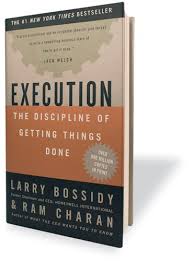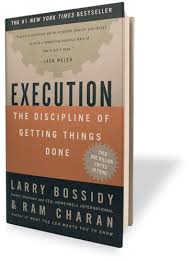I attended the Fortune Growth Summit in October and heard Ram Charan speak. Ram is a world-renowned business advisor, author and speaker who has spent the past 35 years working with some of the top companies and CEOs in the country. I was first introduced to his work when I read Execution: The Discipline of Getting Things Done, that he co-wrote with Larry Bossidy, the
former CEO of Honeywell. I highly recommend the book if you have not read it. He took a different approach than most to his presentation, using an overhead projector with one handwritten transparent outline and no supporting slides. There were many excellent speakers at the summit, but I think Ram’s message came across with a clarity that really resonated with the audience.
So here are the main points I took away for the Ram’s presentation on the “How of Growth”:
1. Visualize your value added in terms of the customer’s need.
Execute well, and if the customer prefers you, you will grow. Ask yourself, is this valuable to the customer and will they prefer it? Is it clear, simple, communicated? If you deliver, the growth will come.
Go to the customer and ask three questions:
1. What are you getting?
2. Why are you getting it?
3. Why do you prefer it?
2. What is good growth?
Good growth has four criteria. All are necessary.
1. The customer prefers you, and at the same time the customer creates referrals for you. There is no better way to create loyalty and a growth trajectory.
2. Compared to the competition, you are better than others.
3. It is profitable. Sometimes you have periods where you are investing, and these are the exceptions.
4. It generates cash. If your business is not generating cash, rethink the business model. You need cash to grow.
Many great businessmen have been self-educated and developed good growth over time.
How was Sam Walton able to continue to provide the lowest prices? Sam got vendors to lower margins to increase their inventory turn to lower his prices to encourage consumers to buy more. Learn your money-making formula in the simplest terms.
Steve Jobs used technology that already existed. He integrated various technologies with a clear mind to determine what the customer wants to experience.
3. How can you double your personal capacity?
How can you accomplish more with less effort? You should strive to identify three ways to double your personal capability every four to five years. Here are a few tips:
No athlete ever became a champion without practicing to win.
It is always people before strategy.
The purpose of time management is to select a few things and focus on them disproportionately. Nail down the three or four things and simplify.
4. Learn from the experiments of others.
Seek out those who can help you. Be prepared for rejection and be persistent.
Search for big ideas. They are usually less than fifteen words. They are simple but have large impact. Dell needed to change their model because they had no cash, to write off computers that are not sellable, so they began to make to order. Read history to learn what ideas worked and did not. How big of an impact did they have?
Recruit better people than you are. Take insecurity out of the picture. Be honest, is this person better than I am?
Put the right people in the right jobs in the context of the future, not just the present.
5. Building blocks of sustainable growth depend on the right culture.
Do I practice "what will the customer want and prefer"? Culture comes from practice.
Spend fifteen minutes during your weekly staff meeting asking what does the customer really need?
What is it the customer wants that we do not have?
Which competitor did you visit yesterday? What does he do better than you? By observing the customer, you are looking for new demand.
There is an old Indian saying, “no customer, no lunch.”
6. Speed is a competitive advantage.
Work to achieve customer continuity by focusing on retention. Exercise speed and adaptability to insure you are meeting the needs of your customer. Make an annual investment in productivity, people, technology and infrastructure. Invest every year in future growth - balance long-term and short-term investments. Do not sacrifice investment in growth to realize the power of compound interest
7. Develop an ecosystem.
Find the right partners and execute. Build relationships, partnerships with outside companies. This is what Microsoft and Intel did to achieve 92 percent and 80 percent margins. Build businesses together to gain a competitive advantage.
8. Focus on building a board and plan for succession.
A large number of companies fail because they do not effectively plan for succession internally and externally. Business genealogy does not always pass to the next generation. Siblings should not be entitled to assume leadership positions if they are not qualified.
Use advisory boards by surrounding yourself with 4 or 5 strong people that have successfully done what you are trying to do.
9. Practice the above repeatedly.
The ability to execute is a competitive advantage and speed is the differentiator.
Ram concluded by asking, what two ideas can you take back and execute now in your business? I’ll conclude by asking you the same question.
Good luck, Alan
Photo Credit: iStock by Getty Images



 LinkedIn
LinkedIn
 Facebook
Facebook
